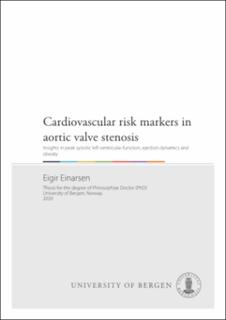| dc.contributor.author | Einarsen, Eigir | |
| dc.date.accessioned | 2020-12-03T13:07:01Z | |
| dc.date.available | 2020-12-03T13:07:01Z | |
| dc.date.issued | 2020-12-04 | |
| dc.date.submitted | 2020-11-17T12:18:52.514Z | |
| dc.identifier | container/55/d5/6a/ba/55d56aba-82a1-422c-bec4-4b832f191611 | |
| dc.identifier.isbn | 9788230865798 | |
| dc.identifier.isbn | 9788230855560 | |
| dc.identifier.uri | https://hdl.handle.net/11250/2711723 | |
| dc.description.abstract | Background: Aortic valve stenosis (AS) is the most prevalent valvular heart disease requiring valvular intervention. With no pharmacological treatment available, optimal management requires detection of early left ventricular (LV) systolic dysfunction, accurate grading of AS severity and identification of risk factors associated with residual cardiac damage after aortic valve replacement (AVR). This thesis aimed to address these concerns.
Material and methods: This thesis include three papers based upon two different cohorts. In Study 1, we prospectively included 120 patients with mild, moderate and severe AS in a cross-sectional study to investigate the covariates of the first-phase ejection fraction (EF1), a novel marker of peak systolic function in AS. In Study 2 we included 1530 patients with asymptomatic non-severe AS from the Simvastatin and Ezetimibe in Aortic Stenosis (SEAS) study to evaluate the prognostic impact of increased acceleration ejection time (AT/ET) ratio on cardiovascular (CV) outcome during progression of AS. In study 3, we explored the association between preoperative obesity and persistent LV hypertrophy after AVR in 399 patients who developed severe AS during follow-up in the SEAS study.
Results: In Study 1, EF1 was associated with lower strain rate, a marker of myocardial contractility, and higher pulse pressure/stroke volume index, a surrogate of arterial stiffness, independent of AS severity. EF1 declined from mild to severe AS, while EF remained similar across groups. In Study 2, higher AT/ET ratio was an independent predictor of poor outcome in the total study population and among patients with discordantly graded AS. An AT/ET ratio >0.32 was found to be the best cut-off to predict CV death and heart failure (HF) hospitalization among patients with discordantly graded AS. In Study 3, preoperative obesity was strongly associated with persistent LV hypertrophy after median a 6 months follow-up 6 after AVR. In multivariable analysis, this association was independent of lower myocardial function and higher systolic blood pressure pre-AVR.
Conclusion: In patients with varying degree of AS severity in Study 1, lower myocardial contractility and higher arterial stiffness were both independently associated with lower EF1. In Study 2, higher AT/ET ratio was associated with increased CV morbidity and mortality independent of traditional risk markers. Higher AT/ET ratio seemed especially useful in patients with discordantly graded AS, beyond conventional grading. Lastly, in Study 3, obesity was found to be independently associated with higher prevalence of LV hypertrophy, an important prognostic marker in postoperative AS patients. | en_US |
| dc.language.iso | eng | en_US |
| dc.publisher | The University of Bergen | en_US |
| dc.relation.haspart | Paper I: Einarsen E, Hjertaas JJ, Gu H, Matre K, Chowienczyk PJ, Gerdts E, Chambers J, Saeed S. Impact of arterio-ventricular interaction on first-phase ejection fraction in aortic stenosis. Eur Heart J Cardiovasc Imaging. 2021;22(6):650–657. The article is available at: <a href=" https://hdl.handle.net/1956/23760" target="blank"> https://hdl.handle.net/1956/23760</a> | en_US |
| dc.relation.haspart | Paper II: Einarsen E, Cramariuc D, Bahlmann E, Midtbo H, Chambers J, Gerdts E. Higher acceleration ejection time ratio predicts outcome in non-severe aortic valve stenosis. The article is not available in BORA. | en_US |
| dc.relation.haspart | Paper III: Einarsen E, Saeed S, Cramariuc D, Chambers JB, Midtbo H, Gerdts E. Impact of Obesity on Persistent Left Ventricular Hypertrophy After Aortic Valve Replacement for Aortic Stenosis. Am J Cardiol. 2019;123(6):942-7. The article is available in the main thesis. The article is also available at: <a href=" https://doi.org/10.1016/j.amjcard.2018.12.012" target="blank"> https://doi.org/10.1016/j.amjcard.2018.12.012</a> | en_US |
| dc.rights | Attribution-NonCommercial (CC BY-NC). This item's rights statement or license does not apply to the included articles in the thesis. | |
| dc.rights.uri | https://creativecommons.org/licenses/by-nc/4.0/ | |
| dc.title | Cardiovascular risk markers in aortic valve stenosis : Insights in peak systolic left ventricular function, ejection dynamics and obesity | en_US |
| dc.type | Doctoral thesis | en_US |
| dc.date.updated | 2020-11-17T12:18:52.514Z | |
| dc.rights.holder | Copyright the Author. | en_US |
| dc.description.degree | Doktorgradsavhandling | |
| fs.unitcode | 13-25-0 | |

